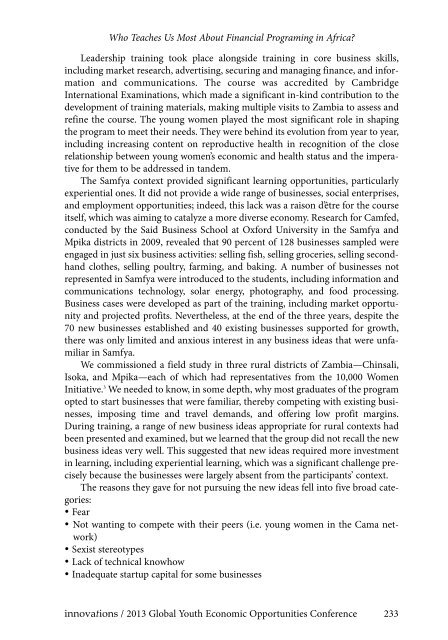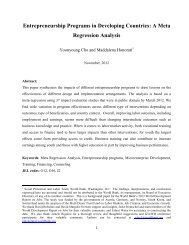Download - Youth Economic Opportunities
Download - Youth Economic Opportunities
Download - Youth Economic Opportunities
Create successful ePaper yourself
Turn your PDF publications into a flip-book with our unique Google optimized e-Paper software.
Who Teaches Us Most About Financial Programing in Africa<br />
Leadership training took place alongside training in core business skills,<br />
including market research, advertising, securing and managing finance, and information<br />
and communications. The course was accredited by Cambridge<br />
International Examinations, which made a significant in-kind contribution to the<br />
development of training materials, making multiple visits to Zambia to assess and<br />
refine the course. The young women played the most significant role in shaping<br />
the program to meet their needs. They were behind its evolution from year to year,<br />
including increasing content on reproductive health in recognition of the close<br />
relationship between young women’s economic and health status and the imperative<br />
for them to be addressed in tandem.<br />
The Samfya context provided significant learning opportunities, particularly<br />
experiential ones. It did not provide a wide range of businesses, social enterprises,<br />
and employment opportunities; indeed, this lack was a raison d’être for the course<br />
itself, which was aiming to catalyze a more diverse economy. Research for Camfed,<br />
conducted by the Said Business School at Oxford University in the Samfya and<br />
Mpika districts in 2009, revealed that 90 percent of 128 businesses sampled were<br />
engaged in just six business activities: selling fish, selling groceries, selling secondhand<br />
clothes, selling poultry, farming, and baking. A number of businesses not<br />
represented in Samfya were introduced to the students, including information and<br />
communications technology, solar energy, photography, and food processing.<br />
Business cases were developed as part of the training, including market opportunity<br />
and projected profits. Nevertheless, at the end of the three years, despite the<br />
70 new businesses established and 40 existing businesses supported for growth,<br />
there was only limited and anxious interest in any business ideas that were unfamiliar<br />
in Samfya.<br />
We commissioned a field study in three rural districts of Zambia—Chinsali,<br />
Isoka, and Mpika—each of which had representatives from the 10,000 Women<br />
Initiative. 3 We needed to know, in some depth, why most graduates of the program<br />
opted to start businesses that were familiar, thereby competing with existing businesses,<br />
imposing time and travel demands, and offering low profit margins.<br />
During training, a range of new business ideas appropriate for rural contexts had<br />
been presented and examined, but we learned that the group did not recall the new<br />
business ideas very well. This suggested that new ideas required more investment<br />
in learning, including experiential learning, which was a significant challenge precisely<br />
because the businesses were largely absent from the participants’ context.<br />
The reasons they gave for not pursuing the new ideas fell into five broad categories:<br />
Fear<br />
Not wanting to compete with their peers (i.e. young women in the Cama network)<br />
Sexist stereotypes<br />
Lack of technical knowhow<br />
Inadequate startup capital for some businesses<br />
innovations / 2013 Global <strong>Youth</strong> <strong>Economic</strong> <strong>Opportunities</strong> Conference 233

















